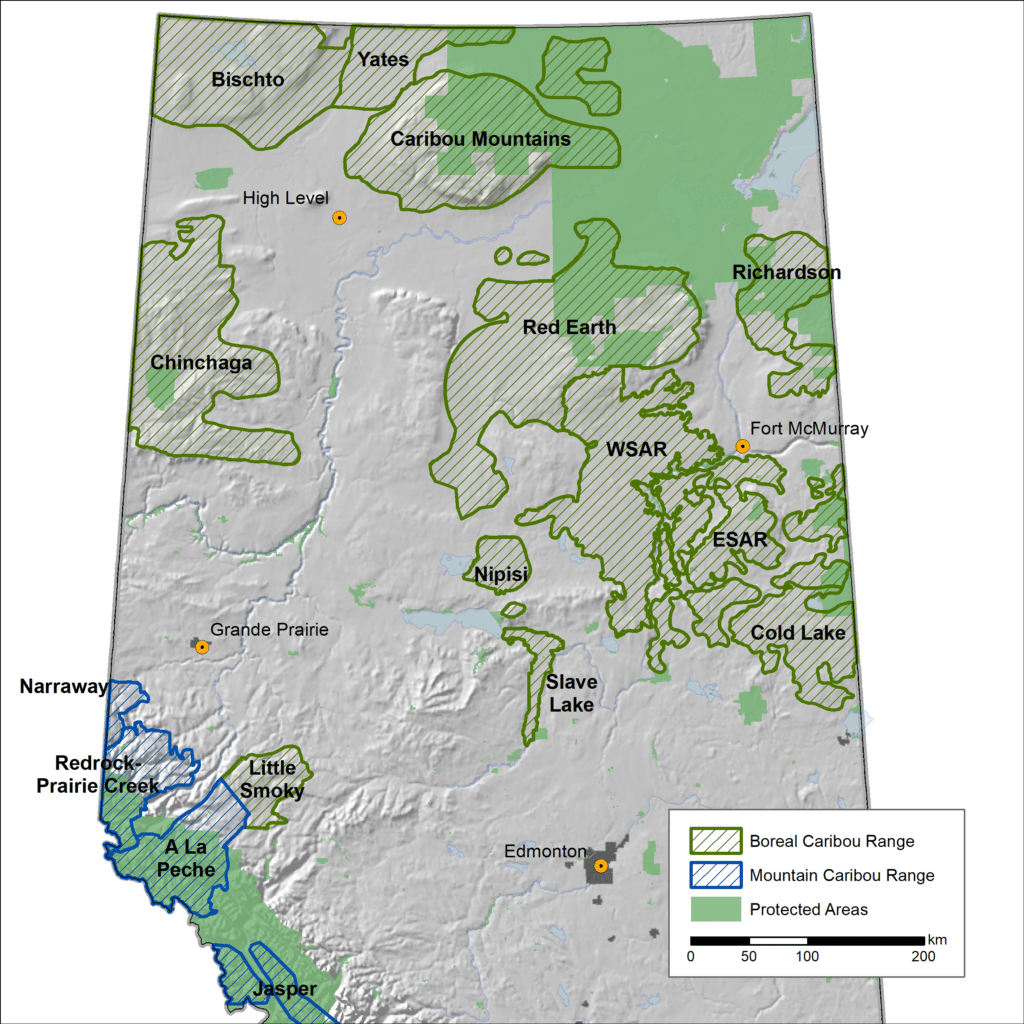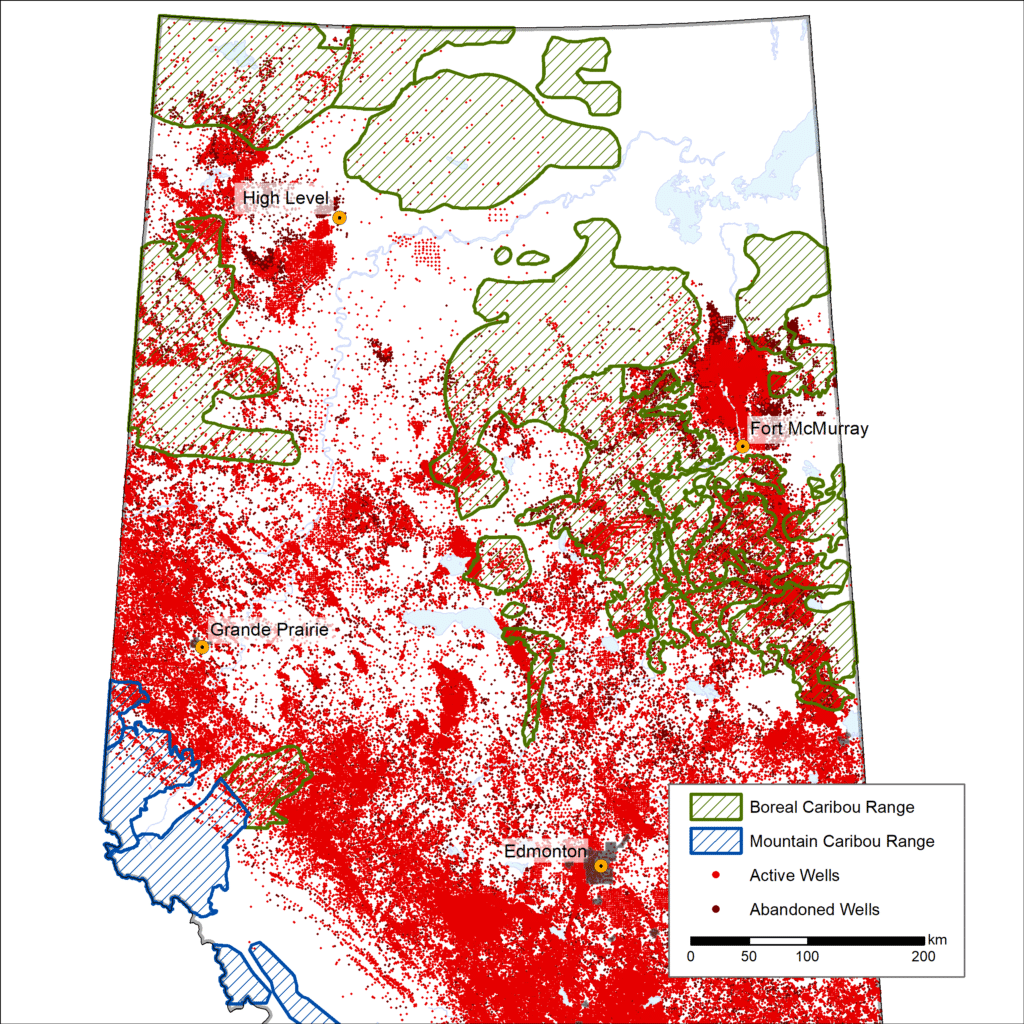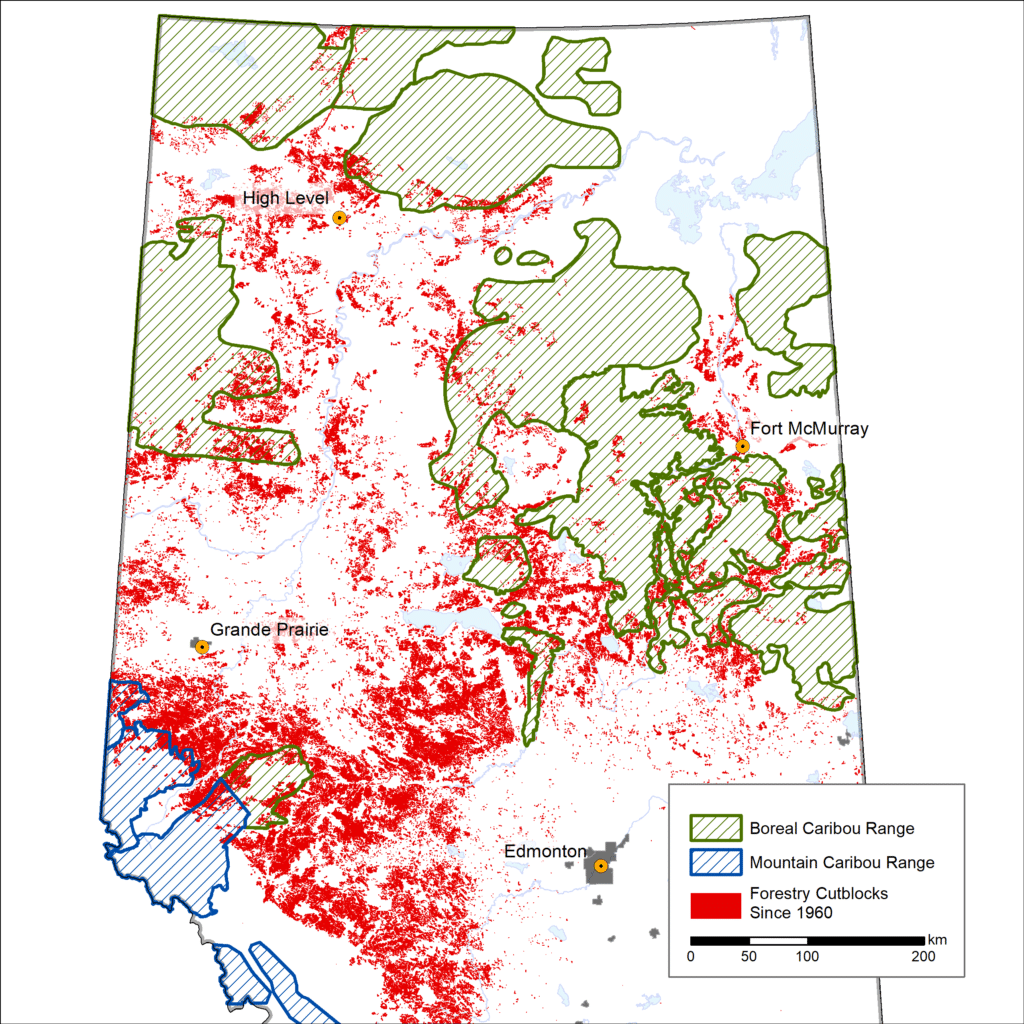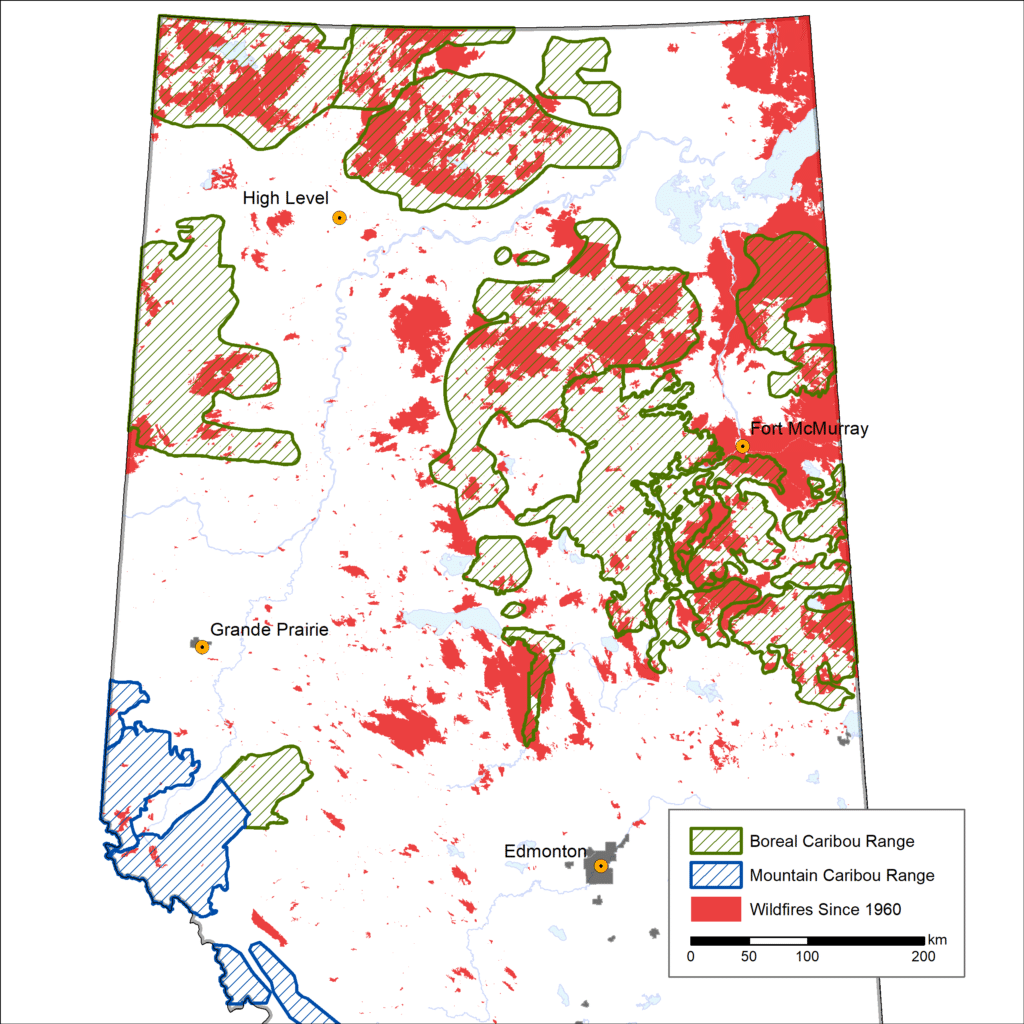Woodland caribou are one of Alberta’s most iconic species, but decades of intense disturbance in the boreal forest has driven their numbers dangerously low, telling us that the overall biodiversity in boreal forest is at risk.
Woodland Caribou: A species at-risk
Woodland caribou populations are in serious decline in Alberta due to the compounding effects of decades of intense industrial development in the boreal forest. Experts have concluded that no caribou herds in Alberta are able to naturally sustain themselves, which means that we will lose caribou on the landscape if we do not act fast. Some herds having experienced over 80% reductions in their population size to date.
The long-term solution to saving declining caribou herds is conservation of caribou habitat through habitat protection and habitat restoration. An intact boreal forest makes sure caribou have enough to room to safely move, feed, breed, and raise calves.
Woodland Caribou in Alberta

Woodland caribou are found in almost every province and territory in Canada. They are an ecologically, socially, economically, and culturally significant species. Check out any 25 cent coin and you’ll see a woodland caribou smiling back at you!
Woodland caribou have very unique habitat requirements. Caribou need large pieces of intact and connected boreal forest, with special focus on old mature forests and lush wetlands. Here, they can successfully hide from predators and eat loads of their favourite food: lichens! When caribou populations are healthy, it tells us that our boreal forests are also healthy because it means there is a diversity of habitats, including older trees and intact wetlands.
Sadly, rapid industrial expansion has completely changed the landscape for caribou. In Alberta, impacts from many different kinds of industries add up on top of each other, leaving very few safe places left for caribou. Caribou ranges experience disturbance from many kinds of industries all together, like oil and gas, forestry, coal mining, and oil sands mining. Caribou ranges are highly disturbed - many are considered over 90% disturbed.
Take Action
Protect Our Caribou
woodland caribou declines
The Drivers
Every single one of the 15 woodland caribou herds on provincial lands in Alberta have been heavily impacted by industrial and natural disturbances. It can be hard to fathom how much of the boreal forest has been altered by human activities. Disturbances from oil and gas exploration, active oil and gas operations, forestry, and wildfires have caused broad-scale habitat loss, fragmentation and landscape change unlike anything seen before.
Wolf & Predator Population Increases
Human disturbances can attract and bolster prey species, like moose and white-tailed deer, because they create brand new food sources. This benefits predators, like wolves, that thrive when there are lots of prey. More wolves on the landscape spells bad news for caribou, as the odds of wolf-caribou encounters increases and caribou predation increases. Did you know caribou are not even the primary prey for wolves? Sadly, current predation rates are simply unsustainable for caribou.Roads & Highways
Linear features, like logging roads, trails, and seismic lines, are used by wolves like highways into caribou habitat. This means that wolves, and potentially other predators, have better access to caribou and are more likely to encounter each other - a deadly interaction for caribou.Loss of Mature Forests & Wetlands
Industrial activities cause habitat loss of mature forests and wetlands, where prime caribou food grows. It also fragments the forest and makes caribou habitat less intact, which can negatively affect caribou movements and connectivity within, and between, their home ranges.Caribou Avoid Industrial Features
Caribou generally avoid industrial features and the areas surrounding them. This means that industrial features actually cause more habitat loss than just their own footprint, and might make caribou avoid high-quality areas if they are too close to a wellsite or pipeline, for example.Alberta’s actions
Saving Woodland Caribou
Boreal woodland caribou were listed as Threatened under Canada’s Species At Risk Act (SARA) in 2003. In 2012, the federal Recovery Strategy for boreal woodland caribou was released and outlined the recovery targets for all caribou ranges across the country with a goal of ensuring 65% of caribou ranges were "undisturbed". This is no small feat, with some caribou ranges in Alberta currently more than 90% disturbed.
Under SARA, it is up to the province or territory to create individual “range plans,” which describe how the government will recover the species. The Government of Alberta released the Draft Provincial Woodland Caribou Range Plan for the 15 woodland caribou herds under provincial jurisdiction in December 2017. The draft plan built on an Alberta Woodland Caribou Policy from 2011. The Draft Plan outlined a few lacklustre management options and evaluated the baseline levels of disturbance in each caribou range. This draft range plan was never finalized. d.
Alberta continues to develop range plans across the province, though far beyond the due date set out in SARA. It is important that range plans focus on habitat-based measures. Without long-term habitat-based solutions, it is short-sighted to rely solely on predator control, alternate prey control, penning, or breeding programs.
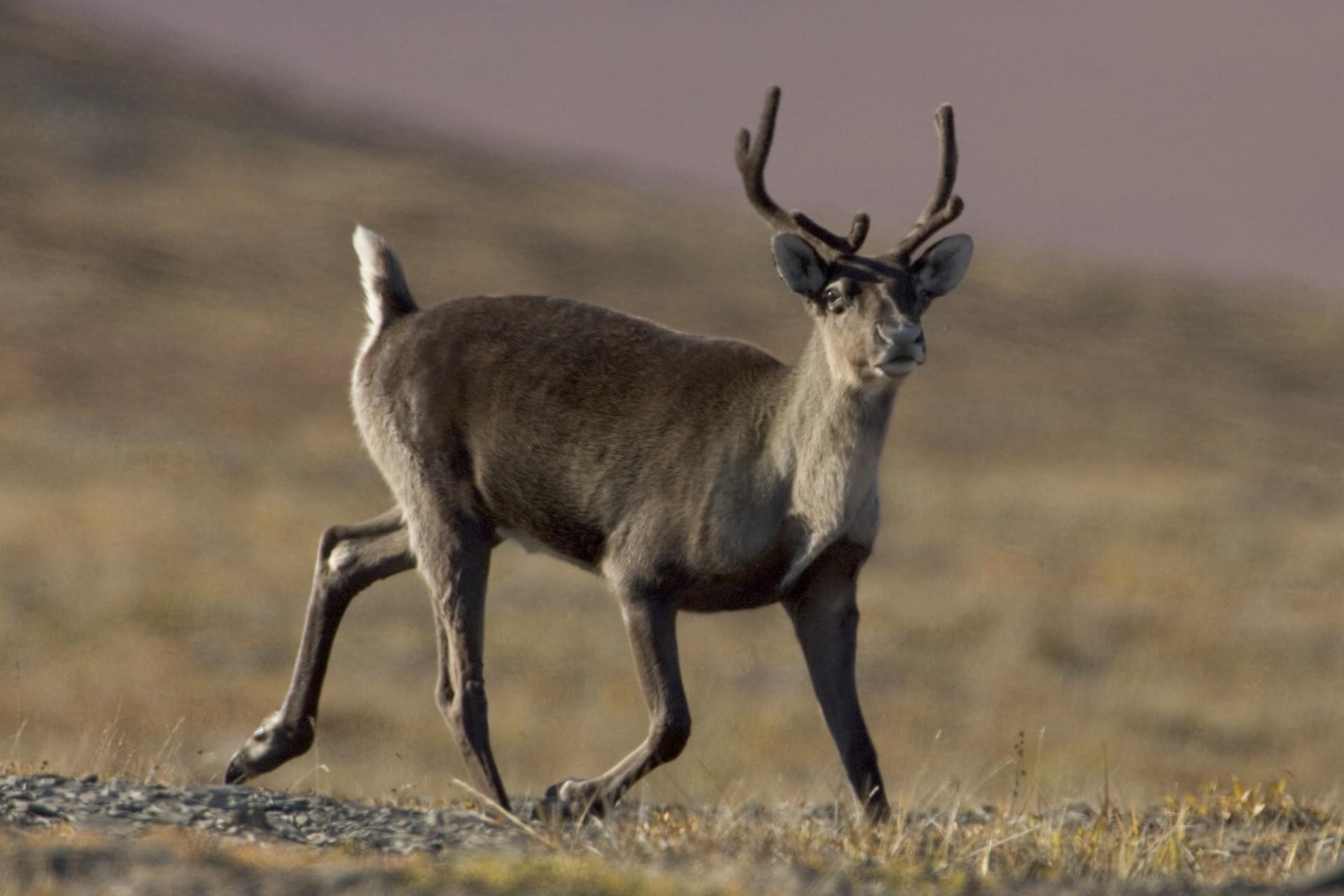
Alberta-Canada Conservation Agreement for caribou

On-the-ground progress
In the summer of 2021, trappers alerted CPAWS to plans by West Fraser Mills Ltd. (Hinton) to log roughly 2,660 hectares of timber within the next two years in the area surrounding Moon Creek, right up to the boundary of the Willmore Wilderness Park. Immediately, alarm bells started ringing for the trappers. This would have been a significant harvest in a uniquely intact old-growth forest—a rarity for any caribou range in Alberta. A CPAWS Northern Alberta analysis showed it would remove 934 hectares of currently undisturbed caribou habitat. Over 900 letters were sent to West Fraser and the Government of Alberta, urging them to pause logging plans in the area.
In 2022, the area was listed as a no-harvest zone.
Caribou recovery in Alberta
We advocate for the protection of caribou habitat and holds government accountable for the implementation of species recovery plans.
We focus on four key actions:
- Ensure at least 50% of the Boreal forest is protected from industrial use and includes critical habitat for woodland caribou;
- Negotiate with forestry companies and other industry partners to protect more caribou habitat from industrial disturbance and responsibly manage within caribou ranges
- Ensure restoration of disturbed caribou habitat so it can become suitable caribou habitat in the future
- Ensure caribou recovery plans prioritize involvement from Indigenous communities

CPAWS’ Guides
Range Planning
In 2016, CPAWS Northern Alberta released three reports illustrating on-the-ground status of and threats to Alberta’s boreal woodland caribou. The reports are the first of their kind in Alberta – the first publicly available, science-based assessment that illustrates where in Alberta’s boreal forest conservation efforts, legislated protection, and immediate forest restoration need to occur in order to bring Alberta’s caribou back from the brink.
Read and download the three volumes of guides produced by CPAWS Northern Alberta.
Take Action
Protect Our Caribou
STAY INFORMED
Protect the Wilderness
To receive news and updates from CPAWS Northern Alberta, including opportunities to get involved, join our mailing list below.

